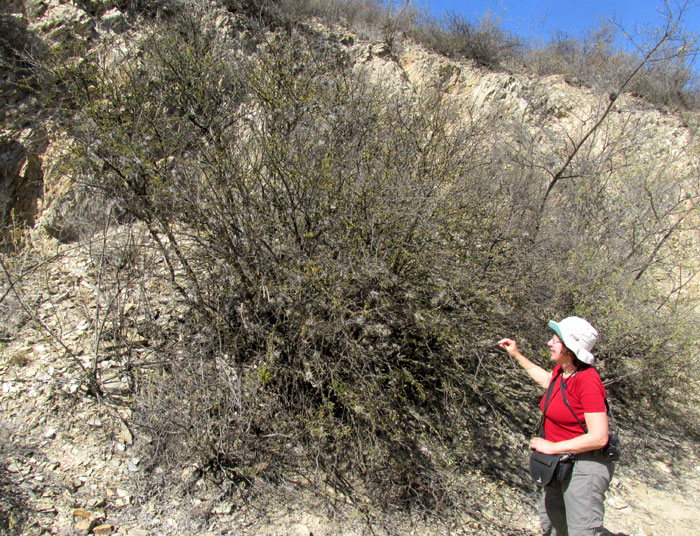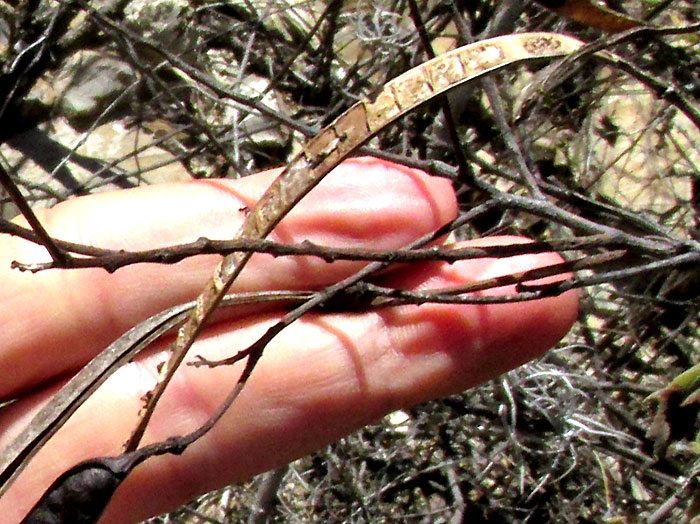Excerpts from Jim Conrad's
Naturalist Newsletter
entry from field notes dated January 20, 2023, taken in scrub ~1.5km south of Camargo, elevation ±1,700m (7280 ft); bedrock of fine-grained, calcareous mudrock; Querétaro state, MÉXICO, (N21.09°, W99.73°)
CANYON SENNA DURING DRY SEASON

Along an old roadcut the above big, woody bush, now in the dry season after the last rainy season never quite developed, had lost nearly all its leaves. Below, you can see some of the few remaining ones.

My first impression had been that we had some kind of acacia, but the leaves shown above are once-pinnately compound, while those of American acacia species normally are twice compound. The small leaves arose from short, woody stubs along the branches, and at the petioles' bases there were sharp-pointed, scale-like stipules, very like what's seen among the acacias. This species was sending mixed signals. Fortunately, the bush retained a few mature legume-type fruits:

These looked just like certain acacia-species legumes. However, one legume had split open, seen below:

I'd not seen acacia legumes with so many squarish seed compartments neatly lined up in continuous squares. It could have been a mimosa legume, but when mimosa fruits open, the squares containing the seeds often fall out, leaving the legumes' ribs on the stems, but the above fruits clearly open along their ribs, revealing seed compartments not going anywhere. Mesquite species can look like this bush, but their legumes tend to constrict somewhat between the seed compartments.
At this point, the process of elimination suggested that the best bet might be the big, variable, and poorly understood genus Senna, with species known in English as sennas. As the genus Senna now stands, it embraces between 260 to 350 species. Sennas often produce eye-catching yellow flowers, and about 50 species are cultivated.
The Flora del Bajío, which considers flowering plants in our region of upland central Mexico, describes about 19 Senna species for the area. Here, if you have a woody Senna bearing no conspicuous gland on its leaves' petioles or rachises; if the once-pinnately compound leaves consist of six or less pairs of leaflets, and; the leaflets are less than 3cm long (1.2inch), you have SENNA WISLIZENI. And if you look on the Internet for pictures of Senna wislizeni, our big bush and its leaves and legumes match what the pictures show.
Senna species can be herbs or big trees. Back in the Yucatan the little Twin-flowered Senna was common, but in Guatemala there's been the large-tree "Big Senna", with its huge fruits. Both these plants earlier were called cassias, but currently they're sennas.
In the small parts of Texas and Arizona near the Mexican border where Senna wislizeni occurs, often it's called Canyon Senna, sometimes Shrubby Senna, Wislinzeni's Senna and other names. From those borderlands the species extends all through the dry uplands of Mexico south to Oaxaca. Four varieties have been recognized for the species, but in the Bajío Region we have only Senna wislizeni var. painteri. In this region's dry scrublands it's considered somewhat uncommon, except that it's "very abundant" locally in three Querétaro state municipalities, including this location, Peñamiller Municipality.
The 2022 work by Mohammed M. Alshehri and others entitled "A Review of Recent Studies on the Antioxidant and Anti-Infectious Properties of Senna Plants" says this: "The studied pharmacological activities of Senna plants include anti-infectious, antioxidant, anticryptococcus, antitumor, antimutagenic, antiplasmodial, anti-inflammatory, anticancer, antidiabetic, wound healing, and antihelmintic activities." Of our Senna wislizeni it's reported that the plant pigments quercetin and rutin have been isolated. Both compounds are much sold, usually in capsular form, as health supplements. Quercetin is said to scavenge free radicals in the body which, an ad claims, "can damage cell membranes, tamper with DNA, and even cause cell death." Rutin is very similar to quercetin, usually occurs alongside it, and is said to accomplish essentially the same as Quercetin.
In Paul Hersch Martínez's undated web document entitled "La flora medicinal en comunidades indígenas" it's said that in Guerrero State the flowers and latex (?) of Senna wislizeni are used to treat diarrhea and dysentery.